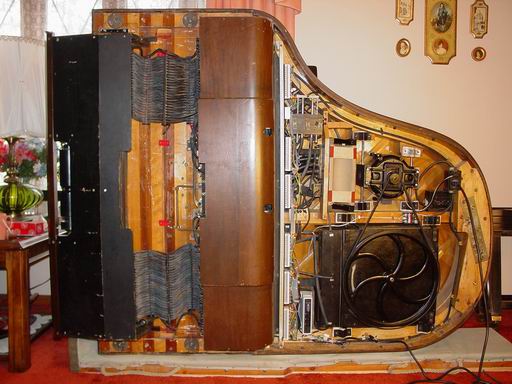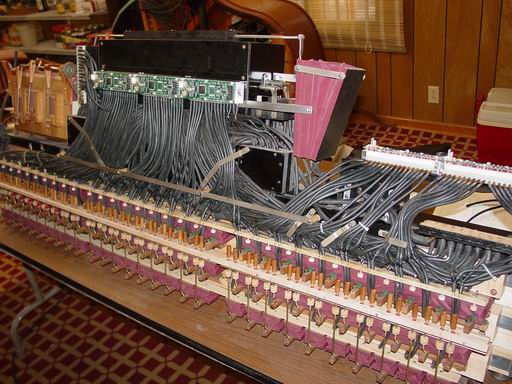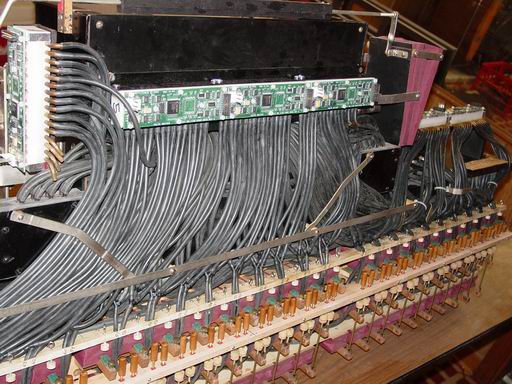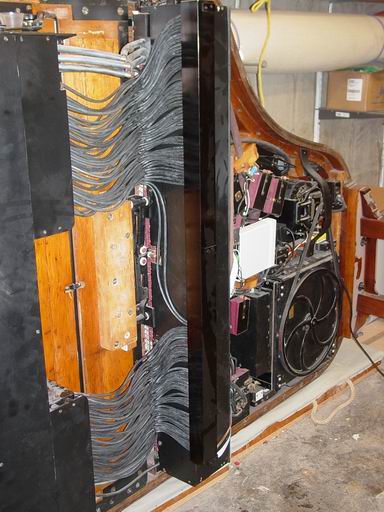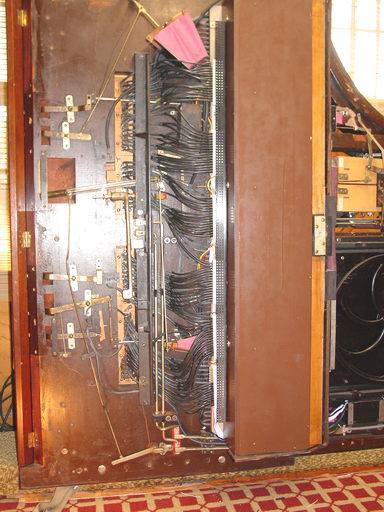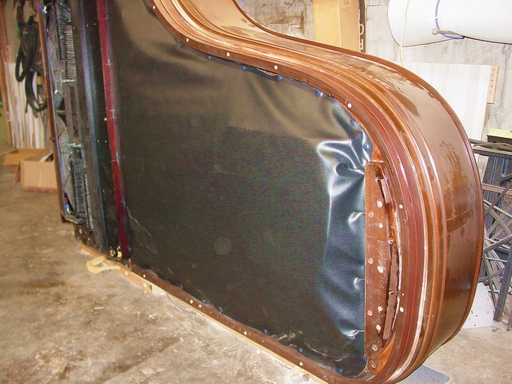|
Pneumatic player pianos today have a real ally in the form of an electronic interface which takes
the place of a paper roll. This system isn't really for the pedaled player pianos. It is intended to
be an alternate music source for pneumatic players like reproducing grands and coin operated
instruments, such as you would find in museums and collections, today. With this system
invisibly installed, one is still able to play rolls without any changes at all. The system is
completely unimposing and does not require mechanical modifications. In other words, the
extent of the modifications required would be probably a dozen screw holes at the very most. It
"Y's" into the trackerbar tubing and unless it's being played, remains airtight to the original
pneumatic system.
This electronic interface today is catching on. I've installed a number of them already, including
a Duo-Art upright, and so far have had excellent performance even with the first units. My own
piano has one of the first 2 that were ever sold, installed in 2001. The valves seem trouble-free
and have been playing, sometimes continuously for 2 hours at a time or longer, for countless
performances. I think a main reason for this reliability is, there's no heat problems. The system
was a real hit when it was demonstrated at this year's 2004 AMICA Convention in Colorado, I
am told, and the makers of this system are now inundated with inquiries and sales about their
new system. I think it is the future of electric pumped pneumatic music machines.( I do not think
it will take the place of rolls pumped manually on a player piano, and was never intended to.)
The advantage of this system to the single instrument owner is obvious. Even greater to the
owner of a collection of instruments! While nothing will take the place of interacting with an
original player roll, singing the words off the note sheet, their original charm and fun for a group
having a player piano party, the E-ROLL PLAYER adds immeasurably to the enjoyment , fun,
and usefulness of the instrument, both when guests are present and when they are not, by
allowing any number of tunes to be programmed from a laptop computer into a "Play list" from
the "Collection" and played- one after the other. Tempos can be reset if desired and then saved
to the "file." But this is just the beginning.
Do you play the piano? Would you like to make a "roll" instantly and have it played back on your
reproducer? Except for expressions, you can do this already if you own an electronic keyboard.
If you have little children, they would like the songs they know, played simply on the piano. You
could do this for them, OR- you could download a vast, unending number of MIDI files available
on the Internet and convert them for your use. But it's much better than that. Reproducing and
88 note rolls have already been scanned onto CDs by the thousands already and available free
for the downloading, as well as those which cost you money. The cost? So far, I estimate it
averages about 3.5 cents/song, and the quality overall is as good as the best roll re-cut on
original factory equipment.
Problems? There are always those occasional tunes that have a few missed notes in them.
However, those are becoming more and more rare as roll scanning improves and the knowledge
increases. In addition, there are now programs which can globally modify any old e-roll that had
a problem and so 99% of them (or better) should play flawlessly now on a good instrument. It's
a better percentage than you would ever expect to get even from all new rolls, with an
additional advantage- you would need thousands of square feet of storage space for the number
of rolls you are able to buy on a single CD.
When you consider the overall cost of supplying music for your piano the conventional way,
versus the E-ROLL way, well, a library of only 200 rolls is approximately the cost of the E-Roll
Player installed at the time the player is restored, in my shop. Just about anyone who owns a
reproducing player will have 200 rolls after awhile. 200 songs isn't very many, when you
consider owning the piano for 30-70 years. But think what you would have, in addition to a
collection of 200 rolls, if you then had an additional collection of 5-6 thousand more songs?
Let's talk about what you can do with these collection lists, for a minute. You can sort the
collection by composer, by artist, by the name of the tune. That allows you to select, for
example, a play list of Gershwin, or Liszt, or Tchaikovsky. Or maybe an artist list. Tunes played
by Adam Carroll, Rachmaninoff, or Hoffmann. You can sort collections into collection music
types and then pick only from separate collection groups. It's like having a musical librarian on
the payroll. Drag or click these tunes from the collection to a temporary play list and preview
them if you like. When you have a play list you plan to listen to later, save it. It will always be
there. Name it- like, LISZT LIST (save). Or, DEBUSSY DEPOT. (Save). It's yours from now
on. Whenever you wish to hear your play list, click "Play Lists" in the menu, select that list, and
the piano begins a live performance. If you want to exclude certain selections temporarily, that's
easy, too.
Another advantage is if you plan to have company who likes music, ask them what they would
like to hear, and play it. Or give them your laptop or notepad computer to choose their own play
list from your collections. And of course, if at any time they find a roll they want to hear, they can
immediately play the roll, too. All you have to do is pause or stop the computer program,
momentarily. Very user-friendly.
The fellows responsible for this nifty invention are Spencer Chase and Gene Gerety. You can
click this link to go right to Spencer's web site and read all about it from another point of view.
The address is www.spencerserolls.com
As I write this, some work is being done to get words attached to the music. As this is gradually
done, the music plays on the piano and the computer screen displays the words in time. Certain
Karoke players also have a bouncing ball thingy. With just the facility alone, the owner should be
able to type in his own words, right now. As time goes on and the player software is upgraded,
the upgrades are going to be made available free to any owner of the system so the player sold
with the system will display words to the songs, itself. There's no sense waiting for everything to
get finished, because it never will be "finished." It will have to be continuously upgraded to keep
up with modern computer developments. But the main thing is the interface in the piano, itself.
Once you have that, it will not have to be upgraded, as it will work with all systems, yet
undesigned. The only advantage in buying it sooner rather than later is that it's cheaper today
than it will be later. The guarantee however is done by Gerety and Chase, and I have found that
you can trust them.
A lot of people who aren't "computer-literate" may be squeamish at first to try this system,
thinking that they would just louse it up and then nobody could help them fix it again. Frankly,
that is highly unlikely, since the playing of MIDI files is a simple trick that practically everyone
who owns a computer can do. You will not be out a lot of money to buy a low-cost laptop
computer to play your piano like this. An expensive, top-of-the-line, state of the art computer is
definitely not necessary, and many companies on the internet can sell you the computer you need
for $400 or less. You will be able to get a lot of free songs in MIDI format as well, through your
modem connected to the phone line, or cable. There are simple ways to pay for your computer,
like this.
The connection from the laptop computer to the piano is a small 1/4" cable, about the size of a
microphone cord. There may be cordless systems which would also work. I don't know. My own
connection is run under the floor, in the basement, but since it's a small cord, about the same in
size as lamp cord, it is easy to conceal, if that's a problem. At the computer you will need a MIDI
interface box. These are inexpensive, too. My computer uses a USB interface. All you need to
know is what your computer has for plug inputs. If it has a USB connection, then I would
suggest using that one.
The software player at the time of this writing has a simple mapping function too, for those of
you who are interested in installing their own. By this system you will be able to find any wrong
notes. For instance, you may have mis-tubed it, or you may find that the tubing is too
cumbersome if you keep the blocks in tracker bar order. Quite a few installations require
changes in this aspect of what would be considered "the usual" connection scheme. No problem
however. Locating the changes or mistakes is much simpler today, and the system is re-mapped
to make the correction, electronically.
Installation by the customer cannot of course be as fully performance-guaranteed as an
installation by a trained technician whom the inventors know personally. Much of the
performance depends on how it is installed and what condition the piano is in, in which it was
placed. Then there is always the "Figment Factor." That is a coined word for a "virtual"
performance factor of the imagination. For instance, when you are expecting a subjective
weakness you always find one. When you fear that something will go wrong, something always
seems to pop up. When someone says, " I think that note isn't playing as softly as it should" or
vice-versa, then someone else's imagination perks up and agrees with them. That's the
"Figment Factor." It often doesn't occur to anyone in the room to play the roll and listen for the
same effect, or see how that note sounds.Suspicions seem to transform themselves magically
into reality during an encounter with the unknown, but overlooked procedure and mistakes have
so far solved every single problem and the trouble so far has not been electrical with an e-
valve. Nor has it been in any case, to my knowledge.
This is one reason why having the system installed when the player is restored is such a great
idea. Not only does it come to you debugged and working, but the installation is customized and
clean, without hanging, wadded up cables, perilously exposed and vulnerable electronics, and
little details which you may not be aware of or able to do anything about after the fact, taken
care of. The extra cost, when a big overhaul is decided on is easily absorbed, particularly when
it's like getting an extra 5000 brand, new rolls for nothing. "Buy 200, get 5000 free ones." Or
however you want to think about that. Any way you want to slice it, it's an unbelievably good
bargain and in no way intrudes into the spirit of the player. Instead, a quality professional
installation increases the value and selling potential of any such instrument.
See a few installation pictures attached.
Craig Brougher
|

